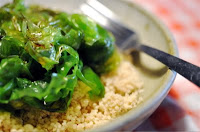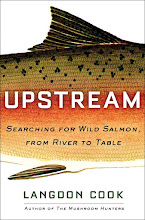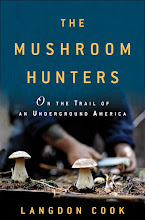
Looking back over the past year and a half of posts, it might seem that here at FOTL headquarters we've managed to run down and sample all manner of wild foods out there for the taking this side of the ungulates. But in reality, we've barely scratched the surface. The rhizome of a buckler fern, for instance, remains an unknown quantity, as do camas bulbs, and unlike some recent gastronauts at the famous Herb Farm, this forager has yet to taste our local slimebag, the banana slug.
A few days ago, however, I filled a major gap in the repertoire. Marty called it my lacuna, and it had been gnawing at me for a while because it's such a Pac Northwest specialty: Geoduck.
Say what? Pronounced gooey-duck, which translates from the Salish into "dig deep," this largest of the world's burrowing clams is a poster child for my region's eccentric character. "Now tell me about those clams again," my dad says to me each time he visits Seattle. Yeah yeah, we've got some big clams with a funny name.
 But geoducks are more than that. They're an unusual delicacy appreciated by clam connoisseurs the world over, most of whom seem to live in the Far East. Secreted deep within their sandy lairs, geoducks live long lives (in excess of 100 years) and grow to tremendous size, with reports of 'ducks weighing as much as 14 pounds. Though found up and down the West Coast, it is in Puget Sound where the geoducks reach their apotheosis, accounting for as much as 2 percent of the Sound's total biomass.
But geoducks are more than that. They're an unusual delicacy appreciated by clam connoisseurs the world over, most of whom seem to live in the Far East. Secreted deep within their sandy lairs, geoducks live long lives (in excess of 100 years) and grow to tremendous size, with reports of 'ducks weighing as much as 14 pounds. Though found up and down the West Coast, it is in Puget Sound where the geoducks reach their apotheosis, accounting for as much as 2 percent of the Sound's total biomass.
The problem is getting at them. A typical geoduck is a couple pounds and buried about three feet beneath the substrate. Most are beyond the intertidal zone, but those that choose to set up house closer to shore are within range of a stealthy clammer during the lowest tides of the year.
 This past Thursday was our last minus tide of significance for 2009's daylight hours. I met my friend Jon Rowley that morning on the ferry to Bainbridge Island. He would be my guide. Besides being the man who introduced most of the civilized world to Copper River salmon, Jon is also a big-time evangelizer of geoduck. We drove to a beach near Quilcene owned by Taylor Shellfish, which has an oyster rearing operation on the property. Ed, one of the staff, assured us that geoducks should be exposed on the lowest stretches of beach. In our rubber boots the three of us headed for the clam beds with a couple sections of 30-inch diameter PVC pipe.
This past Thursday was our last minus tide of significance for 2009's daylight hours. I met my friend Jon Rowley that morning on the ferry to Bainbridge Island. He would be my guide. Besides being the man who introduced most of the civilized world to Copper River salmon, Jon is also a big-time evangelizer of geoduck. We drove to a beach near Quilcene owned by Taylor Shellfish, which has an oyster rearing operation on the property. Ed, one of the staff, assured us that geoducks should be exposed on the lowest stretches of beach. In our rubber boots the three of us headed for the clam beds with a couple sections of 30-inch diameter PVC pipe.
 PVC pipes? Soon I would understand their role in the proceedings. It didn't take long to find the half-dollar sized shows of a couple geoducks. As instructed, I made an impression in the sand with the pipe, dug out the perimeter, and then fitted the pipe back into the circular trough. This humble section of pipe, I now realized, would be my sole fortification against an incursion of wet sand that continually attempted to reclaim my hole. As I dug out the area inside the pipe I worked the PVC deeper into the sand and eventually placed another section on top. Fifteen minutes later both sections, one on top of the other, had disappeared down into the hole.
PVC pipes? Soon I would understand their role in the proceedings. It didn't take long to find the half-dollar sized shows of a couple geoducks. As instructed, I made an impression in the sand with the pipe, dug out the perimeter, and then fitted the pipe back into the circular trough. This humble section of pipe, I now realized, would be my sole fortification against an incursion of wet sand that continually attempted to reclaim my hole. As I dug out the area inside the pipe I worked the PVC deeper into the sand and eventually placed another section on top. Fifteen minutes later both sections, one on top of the other, had disappeared down into the hole.
That's when we noticed the tide. We were past the turn and now the water was coming up again. Fortunately I had constructed something of a sea wall with my diggings. Waves lapped at the berm. "You better hurry up," Jon said calmly. A few more shovelfuls and I got down on my belly to inspect the hole. An average person will extend his arm past the shoulder before having a shot at a 'duck. One of Ed's colleagues at Taylor would tell me a story later about how his brother held him by the ankles and lowered him into a hole. He was 11 years old at the time and their 'duck weighed in at an appropriate 11 pounds.
 About this time I started to get a sinking feeling. The tide waits for no man. Muddy water now filled my hole to the brim. All our effort seemed to be for nought. "Feel around down there again," advised Jon.
About this time I started to get a sinking feeling. The tide waits for no man. Muddy water now filled my hole to the brim. All our effort seemed to be for nought. "Feel around down there again," advised Jon.
"What am I looking for?"
"You'll know when you find it," he said cryptically.
I dug some more, but fatigue was setting in. Despite my PVC bulkhead, each shovelful seemed to be replaced by a steady stream of mud and sand seeping back into the hole. The rising tide was quickly eroding away my berm. We had a few more minutes at most and then the entire operation would be underwater. Already I was composing a blog post in my mind about failure. Out of breath, shoulders and arms aching, I flopped back down on what remained of the beach to take another measurement, if only to get a moment of rest. I had my ear to the water as I reached deep into the hole—and there it was! A rubbery hose-like thing in my grasp. I've got it! I yelled out like a little kid on a treasure hunt. I shook the neck back and forth and worked the clam out of its burrow, finally holding it up in triumph. Every part of me was soaking wet.

Geoduck Ceviche
To clean a live geoduck, immerse it in boiling water for eight seconds. Now you can pull off the thin sheath that protects the siphon. It slips off like a condom, in case you were wondering. Slice off the siphon at the base and nip off the last half-inch or so of the dark tip. This neck meat can be used for sashimi or ceviche. Extract the rest of the clam with a paring knife, cutting the adductor muscles on the inside of the shell. Throw away the bulbous gut and use remaining meat in sauté or stir-fry.
For the ceviche I poked around on the Web a bit. I wanted mine to have kick like Jon's, so a hot pepper would be essential. But I was also looking for some sweetness. Two recipes stood out, Xinh Dwelley's and Bobby Flay's, and so I borrowed bits of each. The ingredient amounts below are rough estimates; adjust to your own taste. I used less than a pound of neck meat.
 1 geoduck neck (siphon), about 1 lb, thinly sliced
1 geoduck neck (siphon), about 1 lb, thinly sliced
1/4 cup red onion, diced
1/4 cup sweet red pepper
1/2 cup cucumber, peeled & chopped
1/2 cup papaya, peeled, seeded & chopped
1 serrano pepper, seeded and finely diced
1 clove garlic, minced
1 handful cilantro, stemmed & chopped
1 tbsp fish sauce
1 tbsp brown sugar
1 tbsp toasted sesame seeds
1-2 limes
salt
1. Combine garlic, hot pepper, fish sauce, and brown sugar into small bowl. Stir with juice from half lime.
2. In large bowl, cover sliced geoduck with juice of 1 lime, stir, and let sit for 30 minutes.
3. Add contents of small bowl to large bowl and add onion, pepper, cucumber, papaya, and cilantro. Stir and season with salt.
4. Chill and serve.
For more 'duck entertainment, watch this trailer for the movie Three Feet Under and this cleaning and cooking demonstration from the Discovery Channel's "Dirty Jobs" show.

 Dear Readers: I'm pleased to announce that my book, Fat of the Land: Adventures of a 21st Century Forager, is now available at a bookseller near you, including Amazon, Barnes & Noble, Powell's, and many independent bookstores across the land.
Dear Readers: I'm pleased to announce that my book, Fat of the Land: Adventures of a 21st Century Forager, is now available at a bookseller near you, including Amazon, Barnes & Noble, Powell's, and many independent bookstores across the land.











































